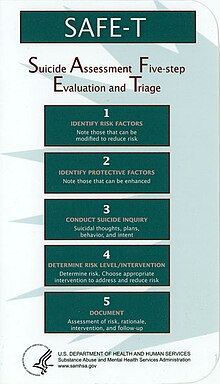
Back Assessment of suicide risk English ارزیابی خطر خودکشی Persian Оценка суицидального риска Russian Suicidriskbedömning Swedish

A suicide risk assessment (SRA) is used to decide an individual's suicide risk (how likely they are to kill themselves). This is a very important first step in helping a person who is thinking of killing themselves. It is best done by a mental health professional, like a counselor. A good, complete risk assessment can lead to a person getting the treatment and help they need, which can reduce or end suicidal symptoms. [1]
The first part of an SRA is talking to a doctor - or other trained mental health worker - who asks specific questions about what the person is thinking about, how they feel, and what is going on in their life. (This is called a clinical interview).
The second part of the SRA uses one or more tests that have been proven to measure suicide risk. These tests are called "scales." A scale is a way of measuring something. Some of these scales have been shown to be very reliable, such as the Suicidal Affect-Behavior-Cognition Scale (SABCS) [2] and the Columbia-Suicide Severity Rating Scale (C-SSRS).
A suicide risk assessment is not always completely right about a person's suicide risk. Still, usually it gives a risk score that is helpful for making important decisions about what treatment the person needs.

An important part of a suicide risk assessment is a clinical interview. This is when a doctor or other qualified person talks to the person who needs help and asks questions about how they are doing.
The risk of suicide may change over time. It may become higher or lower for different reasons. For example, treatment (like counseling or medicines) may work, making the person feel better, or not work. Or the person's life may change in good or bad ways (for example, they may get or lose a job, go to a new school, get a boyfriend or girlfriend, or break up with one).
Because the risk of suicide can change over time, the suicide risk assessment has to be done more than once while the person is in treatment. If the person is in the hospital for treatment, it has to be done before they are sent home.[3]
A suicide risk assessment can be important in helping save the life of a suicidal person. But an article in a journal called Suicide & Life-Threatening Behavior, written in 2012, says that SRAs are often not done, and that many mental health care workers have little or no training in how to do a suicide risk assessment.[4]
Hospitals, doctors, and counselors can be sued for negligible death if a suicidal person goes to them for help, but they never did a suicide risk assessment. Negligible death means that the hospital, doctor, or counselor did not do something they were supposed to do, and because of that, a person died.
- ↑ Jobes, D. A. (2006). Managing suicidal risk: A collaborative approach. New York, NY: Guilford Press.
- ↑ Harris, K. M., Syu, J.-J., Lello, O. D., Chew, Y. L. E., Willcox, C. H., & Ho, R. C. M. (2015). The ABC’s of suicide risk assessment: Applying a tripartite approach to individual evaluations. PLoS ONE, 10(6), e0127442. http://journals.plos.org/plosone/article?id=10.1371/journal.pone.0127442 doi:10.1371/journal.pone.0127442
- ↑ Robert I. Simon Assessing and Managing Suicide Risk: Guidelines for Clinically Based Risk Management Amer Psychiatric Pub; 1 edition (2003) pp.37-40 ISBN 1585621706
- ↑ Schmitz WM Jr1, Allen MH, Feldman BN, Gutin NJ, et al. Suicide Life Threat Behav. 2012 Jun;42(3):292-304. doi: 10.1111/j.1943-278X.2012.00090.x. Epub 2012 Apr 11. Preventing suicide through improved training in suicide risk assessment and care: an American Association of Suicidology Task Force report addressing serious gaps in U.S. mental health training. PMID 22494118
© MMXXIII Rich X Search. We shall prevail. All rights reserved. Rich X Search